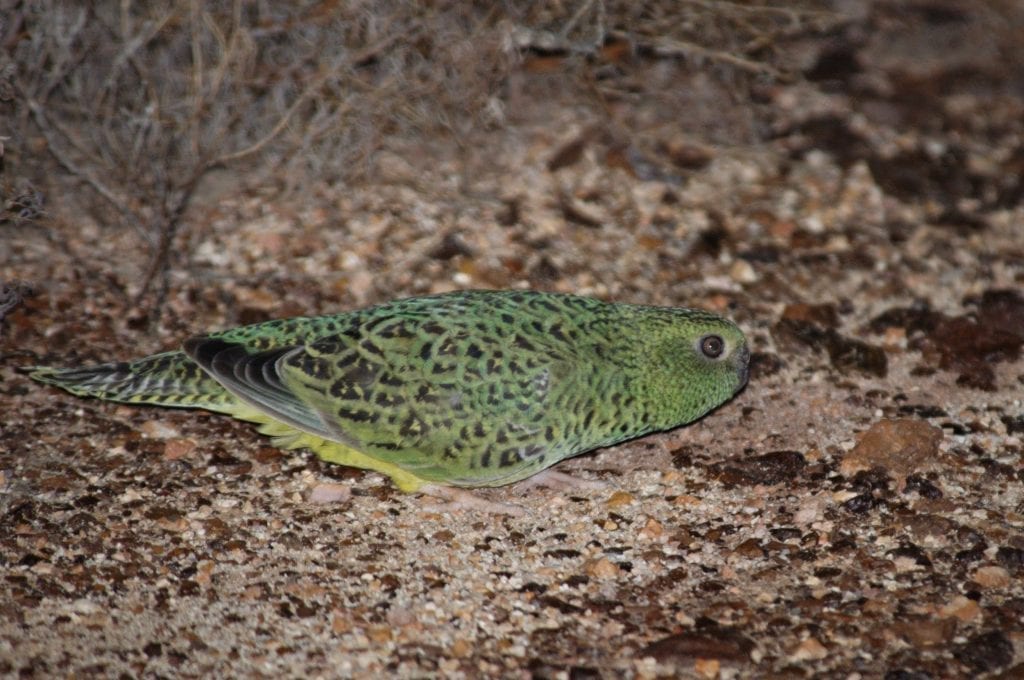National Parks, Nature Refuges, Private Reserves
The night parrot
The night parrot was first recorded by Europeans on Charles Sturt’s 1844 expedition to central Australia and encountered occasionally throughout central Australia until the early 20th century. It then seemed to vanish for reasons unknown, although the finger was pointed, even then, at the spread of pastoralism, feral animals and changed fire regimes.
For much of the 20th century the only evidence of the bird’s existence was an intermittent trickle of reports; some certainly authentic, some undoubtedly not. These reports came from an eclectic mix of explorers, graziers, jackaroos and Indigenous landholders.
Hard evidence of the night parrot’s continued existence was found in 1990 beside a dusty highway near Boulia in western Queensland. Walter Boles, an Australian Museum ornithologist and probably one of few people who knew what he was looking at, spotted the desiccated carcass of a night parrot by the road side. A piece of road-kill. Though other tantalising reports followed verifying its continued existence, the night parrot remained Australia’s least-known bird.
In 2013, on a cattle station in western Queensland, naturalist John Young not only saw the mythical Night Parrot, he recorded its call, photographed one, and even took a short video! After more than a century of hope both the scientific and birding communities were abuzz.
Thanks to a period of intense research that followed, we now know that night parrots in western Queensland seem relatively sedentary and predictably vocal, occupying areas of long-unburnt spinifex, sometimes for extended periods. Year round, the parrots call to each other in the first hour after sunset, and again just before sunrise. In May 2016, a GPS tagged male was found to be travelling several kilometres from his roost to feed on grassy floodplains, stony pavements and small drainage lines, on one night clocking up at least 40 kilometres.
Further research is underway by the Threatened Species Recovery Hub of the National Environmental Science Program to track and confirm the bird’s behaviour in dry periods and develop a more complete picture of its habitat. Investigations are also underway on threats facing the bird. We know that cat numbers are low in the landscape where the parrots occur, and foxes are absent. Work by the TSR Hub, supported by Bush Heritage Australia, is looking at the impact of dingoes on cats. It will also be important, now that grazing is excluded from some of the areas where the birds occur, to monitor any changes this causes in resource availability and its impact on the parrots.
Since 2013, night parrots have been found in Diamantina and Goneaway National Parks and on a couple of nearby pastoral leases. Birds have also been found in central Western Australia, and very recently, what are very likely to be night parrots have been recorded calling at a site in the southern Northern Territory.
Superficially the habitats where these birds occur are quite different and provide many unanswered questions about its population distribution.
Conservation of the night parrot will require an appreciation of how modern conservation techniques can be adapted for the species. As populations are likely to be widely spaced and isolated, it is doubtful that Australia’s protected area estate alone will conserve the species. Instead, integrated conservation measures implemented jointly between state authorities and private landholders will be required.
Pleasingly, in the region where the birds have recently been found in Queensland, landholders have demonstrated a general willingness to assist with night parrot conservation, provided this can be balanced with the demands of managing their land for profit. Given that most night parrots are likely to occur on private land, the goodwill of private landholders will be an important component whatever the direction night parrot conservation takes.


